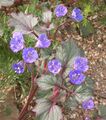Biology:Phacelia campanularia
| Phacelia campanularia | |
|---|---|

| |
| Scientific classification | |
| Kingdom: | Plantae |
| Clade: | Tracheophytes |
| Clade: | Angiosperms |
| Clade: | Eudicots |
| Clade: | Asterids |
| Order: | Boraginales |
| Family: | Boraginaceae |
| Genus: | Phacelia |
| Species: | P. campanularia
|
| Binomial name | |
| Phacelia campanularia A.Gray
| |
Phacelia campanularia is a species of flowering plant in the borage family, Boraginaceae, known by the common names desertbells,[2] desert bluebells,[3] California-bluebell,[4] desert scorpionweed,[5] and desert Canterbury bells.[6] Its true native range is within the borders of California ,[3][7][5] in the Mojave and Sonoran Deserts, but it is commonly cultivated as an ornamental plant and it can be found growing elsewhere[8] as an introduced species.
Description
This annual herb has an erect stem reaching 0.7 metres (2.3 ft) in maximum height. It is covered in glandular hairs. The leaf blades are somewhat rounded with toothed edges. The inflorescence is a loose cyme of flowers. The flower has a bright blue corolla up to 4 centimeters long which can be bell-shaped, funnel-shaped, or round and flattened. It can have white spots in the throat. The protruding stamens and style can be 4.5 centimeters long. The fruit is a capsule up to 1.5 centimeters long.[9] It grows in dry, sandy places below 4,000 feet (1,200 m).[6]
Taxonomy
Two subtaxa are usually recognized, called subspecies[3] or varieties.[9] They can intergrade in some areas.[9]
- Phacelia campanularia ssp. campanularia – limited to the Sonoran Desert
- Phacelia campanularia ssp. vasiformis – more common, with a wider range, and sometimes with larger flowers
Chemistry
The anthocyanin pigment phacelianin was isolated from the flowers of this species and is involved in the formation of their blue color. It is also responsible for the blue of the flowers of Evolvulus pilosus.[10]
The juice, sap, or hairs may cause irritation or a skin rash and should be washed from skin as soon as possible.[11]
Gallery
References
- ↑ "NatureServe Explorer 2.0". https://explorer.natureserve.org/Taxon/ELEMENT_GLOBAL.2.146581/Phacelia_campanularia.
- ↑ "Phacelia campanularia". Natural Resources Conservation Service PLANTS Database. USDA. https://plants.usda.gov/core/profile?symbol=PHCA3. Retrieved 31 January 2016.
- ↑ 3.0 3.1 3.2 Phacelia campanularia. Calflora.
- ↑ (xls) BSBI List 2007, Botanical Society of Britain and Ireland, https://bsbi.org/download/3542/, retrieved 2014-10-17
- ↑ 5.0 5.1 "NatureServe Explorer 2.0". https://explorer.natureserve.org/Taxon/ELEMENT_GLOBAL.2.146581/Phacelia_campanularia.
- ↑ 6.0 6.1 Phacelia campanularia. Lady Bird Johnson Wildflower Center. University of Texas at Austin.
- ↑ {{citation | mode = cs1 | title = Phacelia campanularia | work = Germplasm Resources Information Network (GRIN) | url = | publisher = [[Organization:Agricultural Research ServAgricultural Research Service (ARS), United States Department of Agriculture (USDA) | access-date = 12 January 2018 }}
- ↑ Phacelia campanularia. USDA PLANTS.
- ↑ 9.0 9.1 9.2 Phacelia campanularia. The Jepson Manual.
- ↑ Mori, M., et al. (2006). Structure of anthocyanin from the blue petals of Phacelia campanularia and its blue flower color development. Phytochemistry 67(6), 622-29.
- ↑ "Toxic Plants (by common name)". University of California. https://ucanr.edu/sites/poisonous_safe_plants/Toxic_Plants_by_common_Name_659/. Retrieved 10 November 2020.
External links
Wikidata ☰ Q161340 entry
 |






